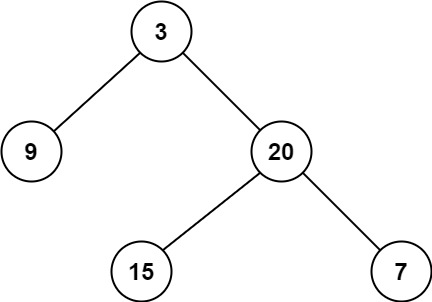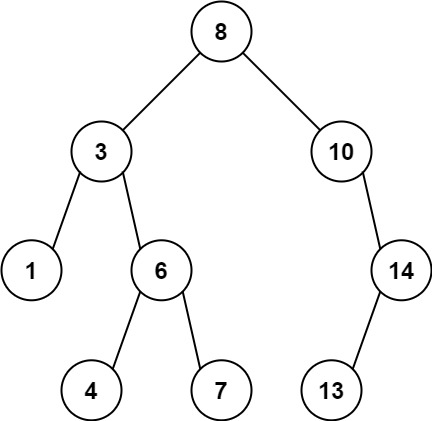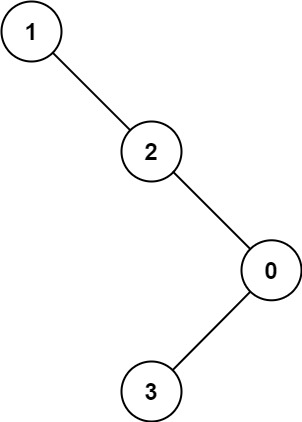Problem 111. Minimum Depth of Binary Tree
-
Given a binary tree, find its minimum depth.
-
The minimum depth is the number of nodes along the shortest path from the root node down to the nearest leaf node.
-
Note: A leaf is a node with no children.
Examples

-
Example 1:
- Input: root = [3,9,20,null,null,15,7]
- Output: 2
-
Example 2:
- Input: root = [2,null,3,null,4,null,5,null,6]
- Output: 5
Constraints
- The number of nodes in the tree is in the range
[0, 105]. -1000 <= Node.val <= 1000
Solution
/**
* Definition for a binary tree node.
* function TreeNode(val, left, right) {
* this.val = (val===undefined ? 0 : val)
* this.left = (left===undefined ? null : left)
* this.right = (right===undefined ? null : right)
* }
*/
/**
* @param {TreeNode} root
* @return {number}
*/
var minDepth = function(root) {
let answer = 50000;
const queue = [[root, 1]];
if (!root) {
return 0;
}
while (queue.length) {
const [node, depth] = queue.shift();
if (depth >= answer) continue;
if (!node.left && !node.right) answer = depth;
if (node.left) queue.push([node.left, depth + 1]);
if (node.right) queue.push([node.right, depth + 1]);
}
return answer;
};Problem 1448. Count Good Nodes in Binary Tree
-
Given a binary tree
root, a node X in the tree is named good if in the path from root to X there are no nodes with a value greater than X. -
Return the number of good nodes in the binary tree.
Examples

-
Example 1:
- Input: root = [3,1,4,3,null,1,5]
- Output: 4
- Explanation: Nodes in blue are good.
- Root Node (3) is always a good node.
- Node 4 -> (3,4) is the maximum value in the path starting from the root.
- Node 5 -> (3,4,5) is the maximum value in the path
- Node 3 -> (3,1,3) is the maximum value in the path.
-
Example 2:
- Input: root = [3,3,null,4,2]
- Output: 3
- Explanation: Node 2 -> (3, 3, 2) is not good, because "3" is higher than it.
- Example 3:
- Input: root = [1]
- Output: 1
- Explanation: Root is considered as good.
Constraints:
- The number of nodes in the binary tree is in the range
[1, 10^5]. - Each node's value is between
[-10^4, 10^4].
Solution
/**
* Definition for a binary tree node.
* function TreeNode(val, left, right) {
* this.val = (val===undefined ? 0 : val)
* this.left = (left===undefined ? null : left)
* this.right = (right===undefined ? null : right)
* }
*/
/**
* @param {TreeNode} root
* @return {number}
*/
var goodNodes = function(root) {
let answer = 0;
const queue = [[root, root.val]];
if (!root) {
return 0;
}
while (queue.length) {
let [node, maxValue] = queue.shift();
if (node.val >= maxValue) {
answer++;
maxValue = node.val;
}
if (node.left) queue.push([node.left, maxValue]);
if (node.right) queue.push([node.right, maxValue]);
}
return answer;
};Problem 1026. Maximum Difference Between Node and Ancestor
-
Given the
rootof a binary tree, find the maximum valuevfor which there exist different nodesaandbwherev = |a.val - b.val|andais an ancestor ofb. -
A node
ais an ancestor ofbif either: any child ofais equal tobor any child ofais an ancestor ofb.
Examples

- Example 1:
- Input: root = [8,3,10,1,6,null,14,null,null,4,7,13]
- Output: 7
- Explanation: We have various ancestor-node differences, some of which are given below :
- |8 - 3| = 5
- |3 - 7| = 4
- |8 - 1| = 7
- |10 - 13| = 3
- Among all possible differences, the maximum value of 7 is obtained by |8 - 1| = 7.

- Example 2:
- Input: root = [1,null,2,null,0,3]
- Output: 3
Constraints
- The number of nodes in the tree is in the range
[2, 5000]. 0 <= Node.val <= 10^5
Solution
/**
* Definition for a binary tree node.
* function TreeNode(val, left, right) {
* this.val = (val===undefined ? 0 : val)
* this.left = (left===undefined ? null : left)
* this.right = (right===undefined ? null : right)
* }
*/
/**
* @param {TreeNode} root
* @return {number}
*/
var maxAncestorDiff = function(root) {
let diff = 0;
let minValue = 100000;
let maxValue = 0;
const dfs = (node, minValue, maxValue) => {
minValue = node.val < minValue ? node.val : minValue;
maxValue = node.val > maxValue ? node.val : maxValue;
if (!node.left && !node.right) {
diff = Math.max(diff, maxValue - minValue);
return;
}
if (node.left) dfs(node.left, minValue, maxValue);
if (node.right) dfs(node.right, minValue, maxValue);
}
dfs(root, minValue, maxValue);
return diff;
};